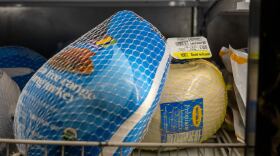It’s common to fly to remote villages in Alaska alongside neatly stacked bags of sugar and bulk packs of laundry pods. Slapped on the packaging is usually a small white sticker with “Bypass Mail” in bold lettering.
The Postal Service created the Alaska-specific program half a century ago. It allows shippers to send pallets of goods to remote communities at a discounted rate on private airlines, in effect “bypassing” the Postal Service entirely.
But the Alaska Bypass program isn’t profitable for the Postal Service. Last year, the program cost the independent federal agency about $80 million more than it took in. That's one-tenth of 1% of the Postal Service’s total budget.
In May, the Postal Regulatory Commission reviewed rates across the service’s products. It found that Alaska Bypass was the only package service to not cover its costs, and recommended a rate hike of at least 2%. The commission eventually passed an increase of 9.39%.
Newly-appointed Postmaster General and CEO, David Steiner, acknowledged at an August board of governors meeting the Postal Service was facing “significant challenges” that have put “significant stress on our business model.”
Steiner went on to tell the board the Postal Service needed to operate in a financially sustainable manner.
“This is not just a good idea, but it’s also required by law,” Steiner said.
Tariffs in the Norton Sound
At Elim’s ANICA grocery store, a 10-pound bag of sugar already costs $29.65, over three times as much as the same bag in Anchorage. A bulk pack of laundry pods costs twice as much as a Fred Meyer in Anchorage.
Aaron Thom is Alaska Native Industries Cooperative Association’s general manager. He called the bypass mail rate increase an added “layer of expense.”
“It's just all boils down to what you see at the register. It all gets calculated in the cost of goods,” Thom said.
ANICA runs stores like Elim’s with Native villages across Alaska. Residents in these communities generally put food on the table by hunting, fishing and berry picking. That $30 bag of sugar is a key ingredient in the berry-filled summer treat, agutaq.

Thom said tariffs enacted by President Donald Trump are also hitting customers at the register. Trump’s tariffs have reportedly raised tens of billions of dollars in revenue for the federal government. Importers pay those tariffs, and have to work out how much of that extra cost to pass down to their customers.
“It's just inflationary costs. You know, yeah, the expenses are growing,” Thom said.
Robert Keith is the president of the Native Village of Elim. He’s worried about tariffs on materials like aluminum, which was recently the subject of a 50% tariff on imports from Canada, the U.S.’ largest supplier.
“We use a lot of aluminum, and a lot of our pop cans are aluminum, and our boats are aluminum, aluminum roofing,” Keith said. “And the tariff issue, you add all this stuff up, it's going to have an impact on our region.”
Across the Norton Sound on the Yukon-Kuskokwim Delta, Stebbins Native Corporation President Thomas Kirk is worried about prices, too.
“It does affect us, and with the companies, too. Not only with the food, but with the cost of goods to keep a company going,” Kirk said.
According to the Denali Commission, just 28% of Stebbins residents over the age of 16 work year-round. The independent federal agency estimates the average individual earns just under $10,000 a year – the lowest of any Norton Sound village.
Kirk said Stebbins residents are relying even more on subsistence foods like moose, salmon and berries, which are often frozen for use throughout the long, subarctic winters.

Lack of air travel options
Limited air travel options are also compounding costs for people in the villages. Ravn Alaska used to operate a nearly identical route map to Nome-based Bering Air, but the airline withdrew from the region in 2020 after filing for bankruptcy. This month, Ravn announced it was canceling all flights across Alaska.
Ravn’s sudden departure left Bering Air and cargo company Ryan Air as the only airlines regularly serving the region’s villages. Kirk said the lack of competition is bad for prices, which only seem to be going up.
“All the airline entities are increasing their extra surplus bag that you try to carry home, which costs about $90 to $300 sometimes, and that's money you could use at home,” Kirk said.
In July, Bering Air halved the amount of free baggage per customer, from 100 pounds to 50. Depending on the total weight, some baggage will fly separately on Bering Air Cargo and is subject to air cargo rates.
Kirk said the challenges he sees in Stebbins are being felt by all 229 federally recognized tribes in Alaska. He said in times like these, he’s grateful he can live off the land.
“In order to survive, you got to learn these skills and try to get involved to feed your family during the winter, during crisis,” Kirk said.






